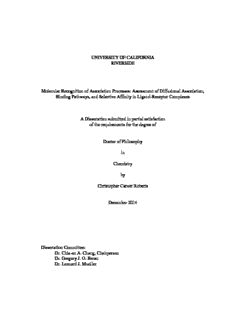
iv ACKNOWLEDGMENTS I would like to express my sincerest appreciation to my advisor, Dr. Chia ... PDF
Preview iv ACKNOWLEDGMENTS I would like to express my sincerest appreciation to my advisor, Dr. Chia ...
UC Riverside UC Riverside Electronic Theses and Dissertations Title Molecular Recognition of Association Processes: Assessment of Diffusional Association, Binding Pathways, and Selective Affinity in Ligand-Receptor Complexes Permalink https://escholarship.org/uc/item/0cc583k7 Author Roberts, Christopher Carver Publication Date 2014 Peer reviewed|Thesis/dissertation eScholarship.org Powered by the California Digital Library University of California UNIVERSITY OF CALIFORNIA RIVERSIDE Molecular Recognition of Association Processes: Assessment of Diffusional Association, Binding Pathways, and Selective Affinity in Ligand-Receptor Complexes A Dissertation submitted in partial satisfaction of the requirements for the degree of Doctor of Philosophy in Chemistry by Christopher Carver Roberts December 2014 Dissertation Committee: Dr. Chia-en A. Chang, Chairperson Dr. Gregory J. O. Beran Dr. Leonard J. Mueller Copyright by Christopher Carver Roberts 2014 The Dissertation of Christopher Carver Roberts is approved: Committee Chairperson University of California, Riverside ACKNOWLEDGMENTS I would like to express my sincerest appreciation to my advisor, Dr. Chia-en Chang, for the guidance and support she has provided during my graduate experience. The research environment she created provided necessary training while also allowing the freedom to explore ideas and topics that most interested me. Her support was critical to my success and progression as a graduate student. My thanks also go out to my committee members, Dr. Beran and Dr. Mueller. Their questions and feedback during my research examinations and oral presentations were invaluable for my improvement as a researcher, and pushed my ability to express my work. I would also like to thank my group members, who provided unique perspectives on my research throughout our shared time together. Finally, I’d like to thank my collaborators for illuminating interesting areas of biology and chemistry to explore. iv Published materials are used as follows: Chapter 2: Roberts, C. C.; Chang, C. A. Modeling of Enhanced Diffusional Association in Multi-enzyme Nanostructures: Effect of Molecular Scaffolds, Spatial Organization, and Concentration. J. Chem. Theory Comput. 2014, (accepted). Chapter 4: Roberts, C. C.; Chang, C. A. Ligand Binding Pathway Elucidation for Cryptophane Host–Guest Complexes. J. Chem. Theory Comput. 2013, 9, 2010– 2019. v ABSTRACT OF THE DISSERTATION Molecular Recognition of Association Processes: Assessment of Diffusional Association, Binding Pathways, and Selective Affinity in Ligand-Receptor Complexes by Christopher Carver Roberts Doctor of Philosophy, Graduate Program in Chemistry University of California, Riverside, December 2014 Dr. Chia-en Chang, Chairperson Molecular recognition processes guide the preferential association of molecular species in chemical and biological systems through physical differentiation and complementarity. Recognition exists at many scales, including the long-range interactions dictating diffusional association, as well as the short-range intermolecular interactions that discriminate the selectivity of a substrate to a host molecule and dictate the configurational transition to the bound state. In this work, methods are developed and employed to study three situations in molecular association processes. Diffusional association was investigated in the intermediate transfer between enzymes in engineered spatially organized nanostructures. In particular, the glucose oxidase- horseradish peroxidase enzyme pair was investigated in several geometric arrangements of DNA-origami scaffolds. A computationally efficient Brownian dynamics software package was developed for the determination of substrate association probability over microsecond to millisecond time scales. We found that arrangements of enzymes on a vi planar scaffold primarily gain efficiency from induced enzyme colocalization with moderate enhancement due to the scaffold acting as a diffusive barrier. Confinement of the enzyme system within a nanotube scaffold greatly enhanced substrate transfer, up to ten fold relative to colocalization, and up to 150 fold relative to a disorganized solution of the enzymes and substrate over the same time period. Our results have implications for the efficient engineering of synthetic enzyme cascades. A computational method was developed for the determination of final non-covalent binding pathways for molecular complexes. Normal mode calculations were used to model coordinated natural motions of a host-guest complex, which were then utilized to connect conformational minima to form non-covalent binding pathways. Our results demonstrate that conformational transitions can be modeled and extended to construct coordinated final binding events. This approach has advantages over simulation-based methods for studying systems with slow binding processes and can help design molecules with preferred binding kinetics. A procedure for determining receptor subtype specificity for inhibitors of the human proteasome was performed. A natural product derivative inhibitor was simulated with molecular dynamics, and molecular recognition was assessed through structural stability and energetic affinity with each receptor subtype. The determined energetic and structural preference for two of the three catalytic sites suggests potential for desirable activity as a human proteasome inhibitor. vii Table of Contents 1. Introduction 1 1.1. Overview 1 1.2. Modeling with molecular mechanics 3 1.2.1. Molecular mechanical theory 3 1.2.2. Force fields 7 1.2.3. Solvent modeling 8 1.2.4. Coarse grain modeling 11 1.3. Techniques and applications to molecular models 14 1.3.1. Minimization 14 1.3.2. Dynamics 16 1.3.2.1. Molecular dynamics 17 1.3.2.2. Brownian dynamics 21 1.3.2.3. Model preparation 23 1.3.3. Structural and energetic analysis 26 1.3.4. Free energy and entropy 28 1.3.5. Docking 31 1.4. References 34 2. Modeling of Enhanced Catalysis in Multi-enzyme Nanostructures: Effect 45 of Molecular Scaffolds, Spatial Organization, and Concentration 2.1. Introduction 45 2.2. Methods 47 viii 2.2.1. Molecular Systems 48 2.2.2. Simulation Configuration 51 2.2.3. Software Implementation and Optimization 53 2.3. Results and Discussion 54 2.3.1. Catalytic Enhancement on a Short Timescale 54 2.3.2. Role on Planar Scaffold on Initial Enhancement 56 2.3.3. Catalytic Enhancement on a Long Timescale 57 2.4. Conclusions 59 2.5. References 61 3. Colocalization in Multi-enzyme Bioreactor Scaffolds: Computational 66 Assessment of Planar and Tubular Geometry Scaffolds 3.1. Introduction 66 3.2. Methods 68 3.2.1. Overview 68 3.2.2. Structure and Preparation 70 3.2.3. Model Parameters 72 3.2.4. Simulation Configurations 73 3.3. Results and Discussion 77 3.3.1. Free Solution 77 3.3.2. Artificially Colocalized Enzymes 78 3.3.3. Planar Geometry Scaffold 79 3.3.4. Tubular Geometry Scaffold 81 ix
Description: